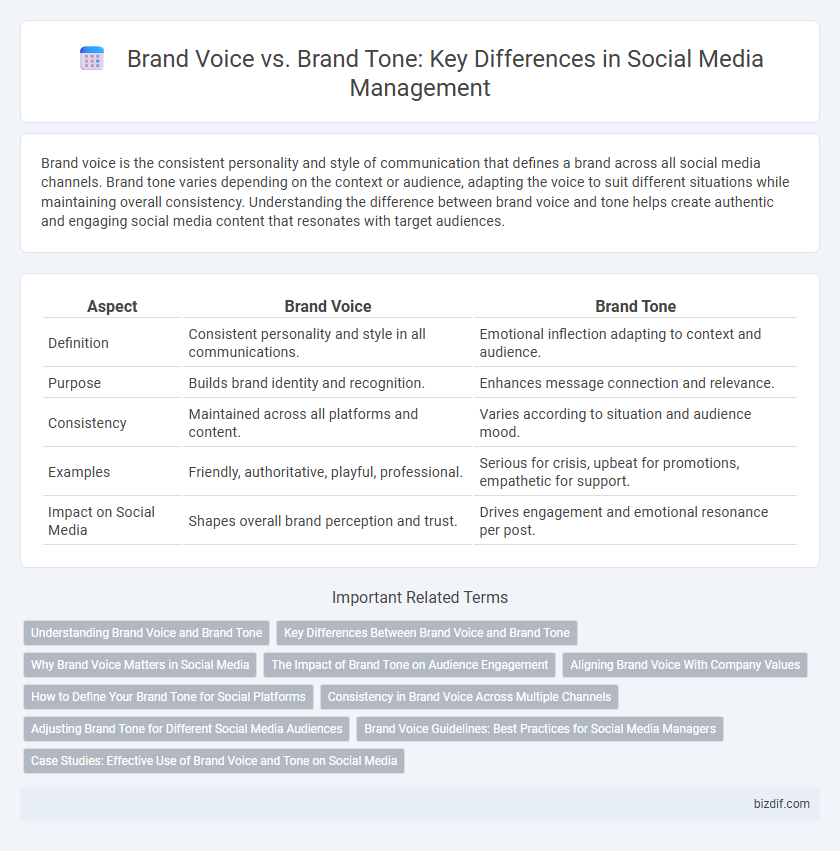Brand voice is the consistent personality and style of communication that defines a brand across all social media channels. Brand tone varies depending on the context or audience, adapting the voice to suit different situations while maintaining overall consistency. Understanding the difference between brand voice and tone helps create authentic and engaging social media content that resonates with target audiences.
Table of Comparison
| Aspect | Brand Voice | Brand Tone |
|---|---|---|
| Definition | Consistent personality and style in all communications. | Emotional inflection adapting to context and audience. |
| Purpose | Builds brand identity and recognition. | Enhances message connection and relevance. |
| Consistency | Maintained across all platforms and content. | Varies according to situation and audience mood. |
| Examples | Friendly, authoritative, playful, professional. | Serious for crisis, upbeat for promotions, empathetic for support. |
| Impact on Social Media | Shapes overall brand perception and trust. | Drives engagement and emotional resonance per post. |
Understanding Brand Voice and Brand Tone
Brand voice is the consistent personality and style that defines how a brand communicates across all channels, reflecting its core values and mission. Brand tone varies depending on the context, audience, and platform, adjusting the voice to evoke specific emotions or responses. Understanding the distinction between voice and tone is crucial for maintaining authenticity while effectively engaging diverse social media audiences.
Key Differences Between Brand Voice and Brand Tone
Brand voice represents the consistent personality and values a brand expresses across all social media platforms, while brand tone adapts to specific contexts, audiences, or campaigns within that framework. Key differences include brand voice being stable and long-term, reflecting core identity, whereas brand tone varies dynamically to suit emotions or objectives in individual posts. Effective social media management requires maintaining a coherent brand voice while adjusting tone to engage target demographics and enhance message resonance.
Why Brand Voice Matters in Social Media
Brand voice establishes a consistent and authentic personality that resonates with the target audience across all social media platforms, enhancing brand recognition and trust. In contrast, brand tone adapts the voice to suit specific contexts or emotions, ensuring messages remain relevant and engaging. Understanding the importance of brand voice in social media helps businesses build a coherent identity that fosters stronger connections and drives customer loyalty.
The Impact of Brand Tone on Audience Engagement
Consistent brand tone significantly influences audience engagement by creating emotional connections that resonate with target demographics. Tailoring tone to reflect brand personality enhances message relatability and fosters trust, boosting interactions such as likes, shares, and comments. Brands that strategically adjust tone across platforms experience higher retention rates and stronger community loyalty.
Aligning Brand Voice With Company Values
Aligning brand voice with company values ensures consistent communication that reflects the organization's mission and culture, fostering trust and recognition among the target audience. Brand voice encompasses the core personality and values, while brand tone adapts to specific contexts without compromising these foundational elements. Maintaining this alignment enhances brand authenticity and strengthens customer engagement across all social media platforms.
How to Define Your Brand Tone for Social Platforms
Defining your brand tone for social platforms begins with understanding your brand voice, which remains consistent across all channels and reflects your core values and personality. Analyze your target audience's preferences and platform-specific communication styles to tailor your tone, whether that's formal, casual, humorous, or authoritative. Use tone guidelines to maintain coherence in posts, comments, and messages, ensuring every interaction resonates authentically with followers and strengthens brand identity.
Consistency in Brand Voice Across Multiple Channels
Maintaining consistency in brand voice across multiple social media channels strengthens brand recognition and trust among audiences. A cohesive brand voice ensures that messaging feels authentic and unified, regardless of platform-specific tone adaptations. Consistent language, values, and style create a seamless user experience, enhancing customer loyalty and engagement.
Adjusting Brand Tone for Different Social Media Audiences
Adjusting brand tone for different social media audiences involves tailoring language, style, and emotional appeal to match platform-specific user expectations and engagement patterns. A consistent brand voice ensures core values and personality remain stable, while flexible tone adapts to demographics on platforms like Instagram, LinkedIn, or Twitter to maximize connection and impact. Effective social media management leverages analytics and audience insights to fine-tune tone, enhancing brand resonance and fostering community growth.
Brand Voice Guidelines: Best Practices for Social Media Managers
Effective brand voice guidelines establish a consistent personality and core messaging that resonate across all social media platforms, ensuring authentic audience engagement. Social media managers should document specific language choices, values, and key phrases to maintain brand integrity while adapting brand tone to suit different contexts and campaigns. Emphasizing clarity, consistency, and relatability in voice guidelines supports cohesive brand recognition and stronger community connection.
Case Studies: Effective Use of Brand Voice and Tone on Social Media
Case studies reveal that brands successfully leveraging a consistent brand voice, such as Nike's motivational and empowering language, foster strong community engagement and loyalty on platforms like Instagram and Twitter. Contrastingly, varied brand tones adapted for specific campaigns or audience segments, as demonstrated by Wendy's witty and humorous responses on Twitter, enhance real-time user interaction and brand personality. Analyzing these examples highlights the importance of distinct, adaptable communication strategies in amplifying social media presence and consumer connection.
brand voice vs brand tone Infographic

 bizdif.com
bizdif.com